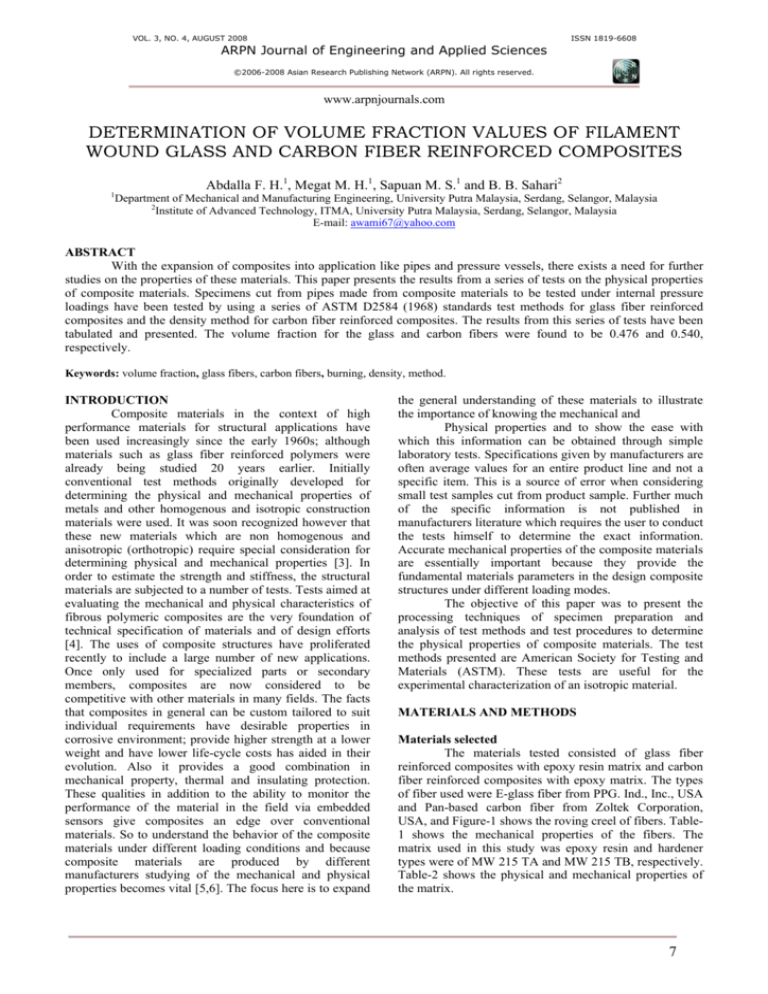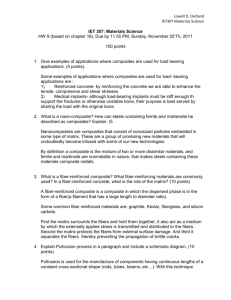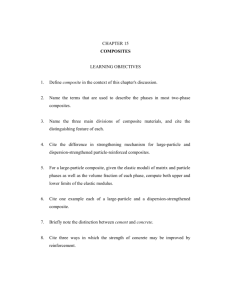
VOL. 3, NO. 4, AUGUST 2008
ISSN 1819-6608
ARPN Journal of Engineering and Applied Sciences
©2006-2008 Asian Research Publishing Network (ARPN). All rights reserved.
www.arpnjournals.com
DETERMINATION OF VOLUME FRACTION VALUES OF FILAMENT
WOUND GLASS AND CARBON FIBER REINFORCED COMPOSITES
Abdalla F. H.1, Megat M. H.1, Sapuan M. S.1 and B. B. Sahari2
1
Department of Mechanical and Manufacturing Engineering, University Putra Malaysia, Serdang, Selangor, Malaysia
2
Institute of Advanced Technology, ITMA, University Putra Malaysia, Serdang, Selangor, Malaysia
E-mail: awami67@yahoo.com
ABSTRACT
With the expansion of composites into application like pipes and pressure vessels, there exists a need for further
studies on the properties of these materials. This paper presents the results from a series of tests on the physical properties
of composite materials. Specimens cut from pipes made from composite materials to be tested under internal pressure
loadings have been tested by using a series of ASTM D2584 (1968) standards test methods for glass fiber reinforced
composites and the density method for carbon fiber reinforced composites. The results from this series of tests have been
tabulated and presented. The volume fraction for the glass and carbon fibers were found to be 0.476 and 0.540,
respectively.
Keywords: volume fraction, glass fibers, carbon fibers, burning, density, method.
INTRODUCTION
Composite materials in the context of high
performance materials for structural applications have
been used increasingly since the early 1960s; although
materials such as glass fiber reinforced polymers were
already being studied 20 years earlier. Initially
conventional test methods originally developed for
determining the physical and mechanical properties of
metals and other homogenous and isotropic construction
materials were used. It was soon recognized however that
these new materials which are non homogenous and
anisotropic (orthotropic) require special consideration for
determining physical and mechanical properties [3]. In
order to estimate the strength and stiffness, the structural
materials are subjected to a number of tests. Tests aimed at
evaluating the mechanical and physical characteristics of
fibrous polymeric composites are the very foundation of
technical specification of materials and of design efforts
[4]. The uses of composite structures have proliferated
recently to include a large number of new applications.
Once only used for specialized parts or secondary
members, composites are now considered to be
competitive with other materials in many fields. The facts
that composites in general can be custom tailored to suit
individual requirements have desirable properties in
corrosive environment; provide higher strength at a lower
weight and have lower life-cycle costs has aided in their
evolution. Also it provides a good combination in
mechanical property, thermal and insulating protection.
These qualities in addition to the ability to monitor the
performance of the material in the field via embedded
sensors give composites an edge over conventional
materials. So to understand the behavior of the composite
materials under different loading conditions and because
composite materials are produced by different
manufacturers studying of the mechanical and physical
properties becomes vital [5,6]. The focus here is to expand
the general understanding of these materials to illustrate
the importance of knowing the mechanical and
Physical properties and to show the ease with
which this information can be obtained through simple
laboratory tests. Specifications given by manufacturers are
often average values for an entire product line and not a
specific item. This is a source of error when considering
small test samples cut from product sample. Further much
of the specific information is not published in
manufacturers literature which requires the user to conduct
the tests himself to determine the exact information.
Accurate mechanical properties of the composite materials
are essentially important because they provide the
fundamental materials parameters in the design composite
structures under different loading modes.
The objective of this paper was to present the
processing techniques of specimen preparation and
analysis of test methods and test procedures to determine
the physical properties of composite materials. The test
methods presented are American Society for Testing and
Materials (ASTM). These tests are useful for the
experimental characterization of an isotropic material.
MATERIALS AND METHODS
Materials selected
The materials tested consisted of glass fiber
reinforced composites with epoxy resin matrix and carbon
fiber reinforced composites with epoxy matrix. The types
of fiber used were E-glass fiber from PPG. Ind., Inc., USA
and Pan-based carbon fiber from Zoltek Corporation,
USA, and Figure-1 shows the roving creel of fibers. Table1 shows the mechanical properties of the fibers. The
matrix used in this study was epoxy resin and hardener
types were of MW 215 TA and MW 215 TB, respectively.
Table-2 shows the physical and mechanical properties of
the matrix.
7
VOL. 3, NO. 4, AUGUST 2008
ISSN 1819-6608
ARPN Journal of Engineering and Applied Sciences
©2006-2008 Asian Research Publishing Network (ARPN). All rights reserved.
www.arpnjournals.com
a
b
Figure-1. Roving Creel for Fiber (a) Carbon Fiber (b) Class Fiber
Table-1. Mechanical properties of composite fibers.
Ef (GPa)
νf
Gf (GPa)
ρ (g/cc)
Carbon fiber
228.0
0.31
41.16
1.81
Glass fiber
72.52
0.33
29.721
2.0
Types of fiber
Table-2. Physical and mechanical properties of the Matrix.
Item
Appearance
Viscosity
Mixing ration
Unit
WM-215 TA
WM-215 TB
White viscous liquid
Colorless liquid
Cps@ 30 C
5500 ±1000
30 ± 20
-
100
25
o
Mechanical Properties of Matrix
Em (GPa)
νm
Gm (GPa)
ρm (g/cc)
3.2
0.28
1.25
1.1
Determination of fiber volume fraction (vf)
In the fiber reinforced material the fibers are
distributed throughout the matrix in a pattern we could
describe as somewhat repeating or periodic. There is
randomness involved but as a first approximation the cross
section could be idealized as square packed array or
hexagonal packed array. The names of the arrays are
derived from the shape of the polygons that describe the
fiber packing pattern and generally the hexagonal array is
the preferred model of the two. Assume that either of the
two models represents to a reasonable degree of accuracy
the microstructure of a fiber reinforced composite material
as shown in Figure-2. By directing the attention to a unit
cell of that model we easily see that the cross-sectional
area of the fiber relative to the total cross sectional area of
the unit cell is a measure of the volume of fiber relative to
the total volume of the composite. This fraction is an
important parameter in composite materials and is called
fiber volume fraction and it is a number between 0 and 1
[7].
Ultimate tensile
stress (MPa)
51
Figure-2. Unidirectional fiber square packing geometry[7]
Glass fiber volume fraction
Since fiber and resin content affect the material’s
mechanical response and properties, they should be
measured for each material tested and accounted for in
8
VOL. 3, NO. 4, AUGUST 2008
ISSN 1819-6608
ARPN Journal of Engineering and Applied Sciences
©2006-2008 Asian Research Publishing Network (ARPN). All rights reserved.
www.arpnjournals.com
predicting mechanical response. The fiber volume fraction
vf can be determined experimentally by weighing a
lamina, then removing the matrix and weighing the fibers
[8]. According to ASTM D2584 (1968) [1,5], four tubular
specimens were prepared to find the volume fraction for
glass fiber composite.
2.
3.
4.
Test method
The specimen is contained in a crucible and is
placed in a furnace degraded leaving only reinforcement
and no filler was used. Once the resin is completely
removed, analysis of the laminate is performed on the
burn-out remains. This method is known as the ignition
loss method or burn-out process. The burning method
(ASTM D2548-68 [1]) has been considered a simple and
effective way to determine the volume fraction of cured
resin composite materials but in many cases it has shown
some limitations when fillers have been added to the
material. The fillers which may be partially burned out or
not burned out at all by the burn-out process stay with the
glass fiber. This causes difficulties in determining the fiber
volume. Until now there has been no standard approach to
separate fillers from the resin and glass fiber of structural
composites [5]. In this work there was no fillers added to
the composite structure produced.
Apparatus
1. Calipers used to measure the length and thickness of
samples.
2. Electric furnace capable of maintaining a temperature
of 5650C for burning out specimens.
3. Weighing scale capable of determining mass to 0.01g.
4. Porcelain crucible approximately 30ml capacity.
5. Safety equipment such as heatproof gloves.
Test specimen
The test specimen composed of the entire crosssection of the profile is needed. The specimen should be
large enough to minimize the error but small enough for
the mass of the specimen to be determined on the
weighing balance. In addition, the specimen after being
cut should show ply orientation in the section.
Pre-test procedure
1.
2.
3.
4.
A table was prepared for recording of the data.
The specimen name and size.
The specimen was measured on each side with
calipers (if the specimen was not uniform multiple
points were measured and the average value were
obtained) and the measurements recorded to the
nearest mm.
The test method was recorded.
Test procedures
1.
A crucible is heated to 6000C for 10min or more. It
was then cooled to room temperature and its mass was
5.
determined to the nearest 1.0mg. This was recorded in
the data sheet.
The laboratory exhaust fan or ventilation system was
turned on.
The mass of the specimen and the crucible together
was determined to the nearest 1.0mg.
The crucible and the specimen were placed in the
furnace. The heating element was turned on to 5650C.
The specimen is allowed to remain in the furnace for a
minimum of two hours or until the entire matrix has
disappeared (extra time is required for thicker
laminates).
The crucible and the remains were removed from the
furnace and cooled to room temperature. Then they
were carefully placed on a gram scale and the post
burn-out mass was determined.
Calculations of volume fraction of glass fiber are as
follows: [9, 10]
(1)
Mc = M f + Mm
(2)
Vf =
Mf
(3)
Vm =
Mm
(4)
Vc = V f + V m
(5)
vf =
(6)
Where
Mc:
Mf
Mm
ρf
ρm
Vc
Vf
Vm
Vf
Vm
ρf
ρm
Vf
Vc
V
vm = m
Vc
Mass of composite specimen, (g)
Mass of glass fiber, (g)
Mass of matrix, (g)
Density of glass fiber, (g/cc)
Density of matrix, (g/cc)
Volume of composite specimen, (cm3)
Volume of glass fiber, (cm3)
Volume of matrix, (cm3)
Glass fiber volume fraction
Matrix volume fraction
RESULTS AND DISCUSSIONS
Four specimens were tested and analyzed to
determine the volume fraction values for glass fiber. The
results are tabulated. Figure-3 shows the specimen before
and after burning. As can be seen that the matrix
completely removed from composite specimen after
burning process and Figure-3b, depict typical fiber
architecture lay-out for typical shape of tubular specimen.
Table-3 shows the results of the volume fraction and it
shows that the fiber volume fractions of the samples
9
VOL. 3, NO. 4, AUGUST 2008
ISSN 1819-6608
ARPN Journal of Engineering and Applied Sciences
©2006-2008 Asian Research Publishing Network (ARPN). All rights reserved.
www.arpnjournals.com
ranged from 46.7% to 48.3%. The average value found for
the glass fiber volume fractions was 47.6%.
a
b
Figure-3. Specimen for volume fraction test (a) before burning (b) after burning.
Table-3. Volume fraction for glass fiber/epoxy composite.
Specimen
No.
Mass of
fiber
(Mf) (g)
1.0602
Mf/Mc
Mm/Mc
1
Mass of
Matrix
(Mm) (g)
0.6662
61.411
2
0.632
1.0468
3
0.6332
4
0.6312
Vf
cm3
0.530
Vm
cm3
0.606
vf
vm
38.589
Vc
cm3
1.136
0.467
0.533
62.3541
37.646
1.098
0.523
0.575
0.477
0.523
1.0494
62.3678
37.632
1.100
0.525
0.576
0.477
0.523
1.0732
62.9664
37.034
1.110
0.537
0.574
0.483
0.517
0.476
0.524
Average
Carbon fiber volume fraction
Experimental measurements of the fiber content
for carbon fiber composite were conducted by the density
method [2]. This method is not recommended for materials
with high porosity like ceramics. Assuming the porosity of
the material is low the fiber volume fraction obtained by
this method can give a quick and good estimate, and
provide a lower bound for the fiber volume fraction value.
The density used for carbon fiber was 1.80 g/cm3, and for
the resin were 1.1 g/cm3 as obtained from Tables 1 and 2.
The fiber volume fraction of the carbon fiber specimens
used in this research is calculated by measuring the density
of the composite in air and in 2-propanol (Alcohol). To
determine the vf, four specimens were cut from tensile
composite specimen; each sample was dried and weighed
in air. Each sample was then immersed in 2-propanol and
weighed in the propanol fluid. The density of the
composite was calculated by Archimedes’ Principle using
the following equation:
ρ c = Wair ρ 2− propanol (Wair − W2− prapanol )
Where
ρc
ρ2-propanol is the density of 2-propanol = 0.782 g/cm3.
Wair
is the weight of the sample in air.
W2-propanol is the weight of the sample in 2-propanol.
The fiber volume fraction is then calculated by using the
rule of mixtures:
v f = (ρ c − ρ re sin ) (ρ fiber − ρ re sin )
(8)
Where
vf is the fiber volume fraction.
ρfiber is the density of the carbon fiber = 1.8 g/cm3.
ρresin is the cured resin density = 1.1 g/cm3.
ρc is the composite density calculated from equation (7).
The fiber volume fractions of the samples ranged
from 53.7% to 54.2% while the value obtained for the
density of the composite was 1.483 g/cm3 as shown in
Table-4. The average value found for the carbon fiber
volume fractions was 54.0%.
(7)
is the density of the composite.
10
VOL. 3, NO. 4, AUGUST 2008
ISSN 1819-6608
ARPN Journal of Engineering and Applied Sciences
©2006-2008 Asian Research Publishing Network (ARPN). All rights reserved.
www.arpnjournals.com
Table-4. Volume fraction of carbon fiber and density of carbon fiber composite.
Specimen
No.
1
Weight in air
Wair (g)
2.1738
Weight in Propanol
W2-propanol (g)
1.0309
Composite density
ρc (g/cc)
1.484
Volume
fraction vf
0.540
2
2.2777
1.0807
1.484
0.541
3
2.0877
0.9909
1.485
0.542
4
2.2616
1.0707
1.481
0.537
1.483
0.540
Average
CONCLUSIONS
Generally manufacturers provide only average
volume fraction values for an entire line of products and it
was found that these data can vary widely among samples
from a particular manufacturer. And these variations are
important to consider since mechanical properties depends
on volume fraction value [5]. So it is necessary to conduct
tests to evaluate the mass or volume fraction of the fiber
when dealing with composite materials. No fillers have
been used in this composite. Although the filler is
typically added to improve the fire resistance and reduce
the cost of a composite and also reduce the voids and
improve the processing viscosity; the addition of the fillers
can reduce the mechanical properties of the composites.
Even small amounts of filler can deteriorate the impact
performance of the material [5]. The volume fraction for
the glass and carbon fibers produced by using filament
winding method are found to be 0.476 and 0.540
respectively.
ACKNOWLEDGMENTS
The authors would like to express their gratitude
and sincere appreciation to the Ministry of Science,
Technology and Innovations, Malaysia (MOSTI, Project
No. 09-02-04-0824-EA001) for the financial support, and
the Department of Mechanical and Manufacturing
Engineering of the University Putra Malaysia for
supporting the group in undertaking the project.
[4] George Lubin. 1985. Static Test Methods for
Composites. Van Nostrand Reinhold Company Inc.
New York, USA.
[5] Binshan S. Y., Alrik L. Svenson and Lawrence C.
Bank. 1995. Mass and Volume Fraction Properties of
Pultruded Glass Fiber-Reinforced Composites.
Research Report, Composites Volume 26 Number 10,
Elsevier Science Limited, U.K.
[6] Sun W. and Tzeng J. T. 2002. Effective Mechanical
Properties of EM Composite Conductors: an
Analytical and Finite Element Modeling Approach.
Composite Structures. 58: 411-421.
[7] Hyer M. W. 1998. Stress Analysis of Fiber Reinforced
Composite Materials. The McGraw-Hill Companies
Inc. USA.
[8] D. Hull, M. J. Legg and B. Spencer. 1978. Failure of
Glass/Polyester Filament Wound Pipe. Composites.
[9] Jones R. M. 1998. Mechanics of composite materials.
2nd Ed. Edwards Brothers, Ann Arbor.
[10] Barbero E. J. 1998. Introduction to composite
materials design. Taylor & Francis, Philadelphia,
USA.
REFERENCES
[1] ASTM D2584. 1968. Standard test method for
ignition loss of cured reinforced resins. Annual book
of ASTM standards, Vol. 8.01, American Society for
Testing and Materials, Philadelphia. pp. 328-329.
[2] Broyles N. S., Verghese K. N. E., Davis S. V., Li H.,
Davis R. M., Lesko J. J. and Riffle J. S. 1998. Fatigue
performance of carbon fiber/vinyl ester composites:
the effect of two dissimilar polymeric sizing agents.
Polymer. 39(15): 3417-3424.
[3] Donald F. Adams, Leif A. Carlsson and R. Byron
Pipes. 2003. Experimental characterization of
advanced composite materials. 3rd Ed. by CRC PRESS
LLC.
11








